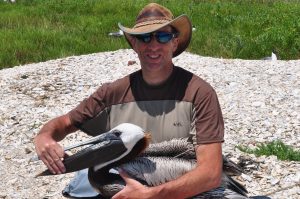 What is your job, what do you work on, and what is your involvement with GoMAMN?
What is your job, what do you work on, and what is your involvement with GoMAMN?
I am the Seabird Taxa Lead for GoMAMN. I recently worked with other GoMAMN members to complete the Seabird Monitoring Chapter and the Avian Health Monitoring Chapter for the Gulf of Mexico Avian Monitoring Network Strategic Monitoring Plan.
I am currently the Leader of the USGS South Carolina Cooperative Fish & Wildlife Research Unit and a Professor at Clemson University. Most of my research focuses on the conservation and ecology of marine birds. In the past several years, our lab has conducted seabird research in the Gulf as well as the Atlantic, Caribbean, and Pacific. We’ve conducted tracking projects on Brown Pelicans in the Gulf, Atlantic, and Pacific. In the Caribbean, we’ve conducted tracking projects on the endangered Black-capped Petrel, Masked Booby, Magnificent Frigatebird, Audubon’s Shearwater, and both White-tailed and Red-billed Tropicbirds. Our lab is also part of the GoMMAPPS team, working primarily with the vessel-based surveys for seabirds.
I also currently serve as the the Chair of the World Seabird Union (2015-2020), a global organization of scientific and conservation organizations focused on seabird conservation and science. Pat is also active in the Pacific Seabird Group (former Chair), Atlantic Marine Bird Cooperative (founding member), and The Waterbird Society.
Are there any particular areas you are seeking collaboration or willing to collaborate with others?
Our lab is particularly interested in any opportunity to conduct seabird research on colonies. We’ve developed a substantial level of experience on a variety of seabirds and are always interested in collaborating with others, particularly state and federal agencies in need of research to address management and conservation actions. Similarly, we’re also interested in opportunities to expand the network of tracking studies on seabirds in the Gulf and elsewhere. The SC Cooperative Research Unit also has expertise in population modeling using Bayesian approaches. And, lastly, I’m always interested in any opportunities to study avian energetics.
Tell us about yourself.
I’m originally from New Jersey (not the shore or the nice parts out west). I did not grow up birding or hunting or fishing (suburban Jersey is not known for that), but was fortunate to have parents who valued state and national parks and our time camping there influenced my career path tremendously. I’ve earned my degrees at University of Maine (my first field job was working on a loon project in northern Maine), University of Florida (MS studying ecology of Big Cypress Fox Squirrels), and Oregon State (PhD studying ecology of Marbled Murrelets and a PostDoc studying the reproductive energetics of seabirds in Alaska). I’ve worked for and with a wide variety of state and federal agencies, and I think that helps me keep a focus on research that can really serve to advance the missions of those organizations. Despite what my work schedule suggests, I do have interests outside of work, including mountain biking, paddle sports, and climbing. GoMAMN meetings do provide some good paddle boarding opportunities!
Besides a coordinated and integrated monitoring program, what do you see as another essential need for furthering avian management in the Gulf of Mexico?
For seabirds in the Gulf, we still are lacking a fair amount of basic data on reproductive ecology, foraging ecology, and movement. These data gaps apply not just to species breeding in the northern Gulf, but also to species breeding in the southern Gulf and to species that migrate to the Gulf from the Caribbean and eastern Atlantic. On the latter, it’s critical that we improve our understanding of the connectivity between migratory seabirds and their colonies of origin. I’m hopeful that the Strategic Monitoring Plan will help to point out these data gaps so that we can continue to try and address them in a way that will advance conservation efforts and the development of monitoring plans in the region.
Where is your favorite outdoor place on the Gulf Coast?
I’m happy to be on any island that supports a seabird colony – the sounds, the activity, and the remoteness all are unique and memorable.
If you could befriend 3 famous people (living or dead), who would they be?
Can I choose to meet the dogs of 3 famous people? I think I’d rather do that.
You’re a major league baseball player. What song do they play to rev up the crowd when you come up to bat?
Wrecking Ball by Springsteen (remember, I’m from Jersey).
Any other little-known fact about you that you’d like to tell us?
I missed a lot of classes as an undergrad at Maine putting up new climbing routes and looking for new cliffs (not sure how my parents put up with me).
What is one thing you know for sure?
I wouldn’t be where I am without the people who really invested in me during the early stages of my career, and without the grad students, research associates, and Post Docs who have invested so much in our lab over the past 15 years.
